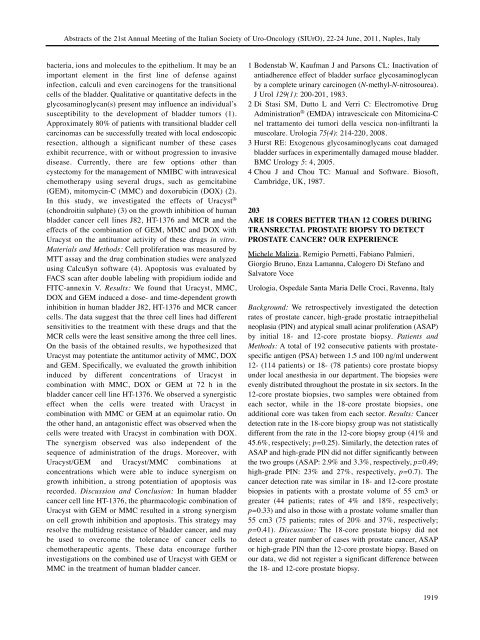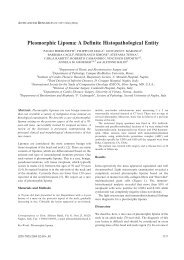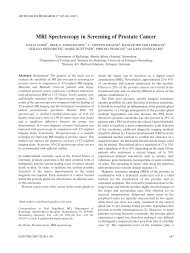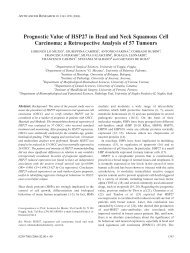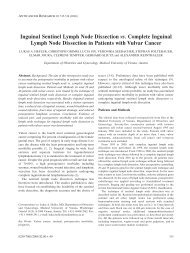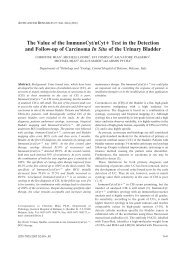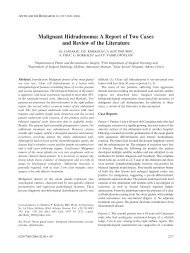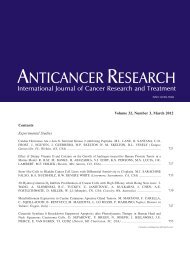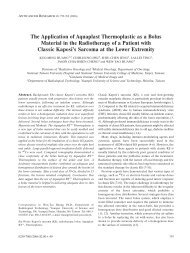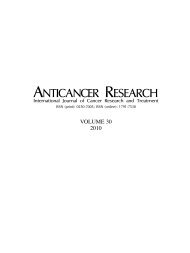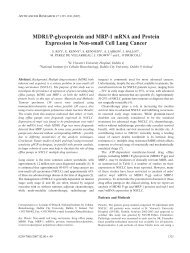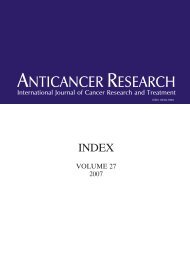ABSTRACTS OF THE 21st ANNUAL MEETING OF THE ITALIAN ...
ABSTRACTS OF THE 21st ANNUAL MEETING OF THE ITALIAN ...
ABSTRACTS OF THE 21st ANNUAL MEETING OF THE ITALIAN ...
Create successful ePaper yourself
Turn your PDF publications into a flip-book with our unique Google optimized e-Paper software.
Abstracts of the <strong>21st</strong> Annual Meeting of the Italian Society of Uro-Oncology (SIUrO), 22-24 June, 2011, Naples, Italy<br />
bacteria, ions and molecules to the epithelium. It may be an<br />
important element in the first line of defense against<br />
infection, calculi and even carcinogens for the transitional<br />
cells of the bladder. Qualitative or quantitative defects in the<br />
glycosaminoglycan(s) present may influence an individual’s<br />
susceptibility to the development of bladder tumors (1).<br />
Approximately 80% of patients with transitional bladder cell<br />
carcinomas can be successfully treated with local endoscopic<br />
resection, although a significant number of these cases<br />
exhibit recurrence, with or without progression to invasive<br />
disease. Currently, there are few options other than<br />
cystectomy for the management of NMIBC with intravesical<br />
chemotherapy using several drugs, such as gemcitabine<br />
(GEM), mitomycin-C (MMC) and doxorubicin (DOX) (2).<br />
In this study, we investigated the effects of Uracyst ®<br />
(chondroitin sulphate) (3) on the growth inhibition of human<br />
bladder cancer cell lines J82, HT-1376 and MCR and the<br />
effects of the combination of GEM, MMC and DOX with<br />
Uracyst on the antitumor activity of these drugs in vitro.<br />
Materials and Methods: Cell proliferation was measured by<br />
MTT assay and the drug combination studies were analyzed<br />
using CalcuSyn software (4). Apoptosis was evaluated by<br />
FACS scan after double labeling with propidium iodide and<br />
FITC-annexin V. Results: We found that Uracyst, MMC,<br />
DOX and GEM induced a dose- and time-dependent growth<br />
inhibition in human bladder J82, HT-1376 and MCR cancer<br />
cells. The data suggest that the three cell lines had different<br />
sensitivities to the treatment with these drugs and that the<br />
MCR cells were the least sensitive among the three cell lines.<br />
On the basis of the obtained results, we hypothesized that<br />
Uracyst may potentiate the antitumor activity of MMC, DOX<br />
and GEM. Specifically, we evaluated the growth inhibition<br />
induced by different concentrations of Uracyst in<br />
combination with MMC, DOX or GEM at 72 h in the<br />
bladder cancer cell line HT-1376. We observed a synergistic<br />
effect when the cells were treated with Uracyst in<br />
combination with MMC or GEM at an equimolar ratio. On<br />
the other hand, an antagonistic effect was observed when the<br />
cells were treated with Uracyst in combination with DOX.<br />
The synergism observed was also independent of the<br />
sequence of administration of the drugs. Moreover, with<br />
Uracyst/GEM and Uracyst/MMC combinations at<br />
concentrations which were able to induce synergism on<br />
growth inhibition, a strong potentiation of apoptosis was<br />
recorded. Discussion and Conclusion: In human bladder<br />
cancer cell line HT-1376, the pharmacologic combination of<br />
Uracyst with GEM or MMC resulted in a strong synergism<br />
on cell growth inhibition and apoptosis. This strategy may<br />
resolve the multidrug resistance of bladder cancer, and may<br />
be used to overcome the tolerance of cancer cells to<br />
chemotherapeutic agents. These data encourage further<br />
investigations on the combined use of Uracyst with GEM or<br />
MMC in the treatment of human bladder cancer.<br />
1 Bodenstab W, Kaufman J and Parsons CL: Inactivation of<br />
antiadherence effect of bladder surface glycosaminoglycan<br />
by a complete urinary carcinogen (N-methyl-N-nitrosourea).<br />
J Urol 129(1): 200-201, 1983.<br />
2 Di Stasi SM, Dutto L and Verri C: Electromotive Drug<br />
Administration ® (EMDA) intravescicale con Mitomicina-C<br />
nel trattamento dei tumori della vescica non-infiltranti la<br />
muscolare. Urologia 75(4): 214-220, 2008.<br />
3 Hurst RE: Exogenous glycosaminoglycans coat damaged<br />
bladder surfaces in experimentally damaged mouse bladder.<br />
BMC Urology 5: 4, 2005.<br />
4 Chou J and Chou TC: Manual and Software. Biosoft,<br />
Cambridge, UK, 1987.<br />
203<br />
ARE 18 CORES BETTER THAN 12 CORES DURING<br />
TRANSRECTAL PROSTATE BIOPSY TO DETECT<br />
PROSTATE CANCER? OUR EXPERIENCE<br />
Michele Malizia, Remigio Pernetti, Fabiano Palmieri,<br />
Giorgio Bruno, Enza Lamanna, Calogero Di Stefano and<br />
Salvatore Voce<br />
Urologia, Ospedale Santa Maria Delle Croci, Ravenna, Italy<br />
Background: We retrospectively investigated the detection<br />
rates of prostate cancer, high-grade prostatic intraepithelial<br />
neoplasia (PIN) and atypical small acinar proliferation (ASAP)<br />
by initial 18- and 12-core prostate biopsy. Patients and<br />
Methods: A total of 192 consecutive patients with prostatespecific<br />
antigen (PSA) between 1.5 and 100 ng/ml underwent<br />
12- (114 patients) or 18- (78 patients) core prostate biopsy<br />
under local anesthesia in our department. The biopsies were<br />
evenly distributed throughout the prostate in six sectors. In the<br />
12-core prostate biopsies, two samples were obtained from<br />
each sector, while in the 18-core prostate biopsies, one<br />
additional core was taken from each sector. Results: Cancer<br />
detection rate in the 18-core biopsy group was not statistically<br />
different from the rate in the 12-core biopsy group (41% and<br />
45.6%, respectively; p=0.25). Similarly, the detection rates of<br />
ASAP and high-grade PIN did not differ significantly between<br />
the two groups (ASAP: 2.9% and 3.3%, respectively, p=0.49;<br />
high-grade PIN: 23% and 27%, respectively, p=0.7). The<br />
cancer detection rate was similar in 18- and 12-core prostate<br />
biopsies in patients with a prostate volume of 55 cm3 or<br />
greater (44 patients; rates of 4% and 18%, respectively;<br />
p=0.33) and also in those with a prostate volume smaller than<br />
55 cm3 (75 patients; rates of 20% and 37%, respectively;<br />
p=0.41). Discussion: The 18-core prostate biopsy did not<br />
detect a greater number of cases with prostate cancer, ASAP<br />
or high-grade PIN than the 12-core prostate biopsy. Based on<br />
our data, we did not register a significant difference between<br />
the 18- and 12-core prostate biopsy.<br />
1919


